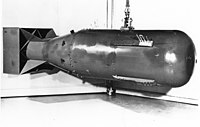
Photo from wikipedia
In response to injury, adult Schwann cells (SCs) re-enter the cell cycle, change their expression profile, and exert repair functions important for wound healing and the re-growth of axons. While… Click to show full abstract
In response to injury, adult Schwann cells (SCs) re-enter the cell cycle, change their expression profile, and exert repair functions important for wound healing and the re-growth of axons. While this phenotypical instability of SCs is essential for nerve regeneration, it has also been implicated in cancer progression and de-myelinating neuropathies. Thus, SCs became an important research tool to study the molecular mechanisms involved in repair and disease and to identify targets for therapeutic intervention. A high purity of isolated SC cultures used for experimentation must be demonstrated to exclude that novel findings are derived from a contaminating fibroblasts population. In addition, information about the SC proliferation status is an important parameter to be determined in response to different treatments. The evaluation of SC purity and proliferation, however, usually depends on the time consuming, manual assessment of immunofluorescence stainings or comes with the sacrifice of a large amount of SCs for flow cytometry analysis. We here show that rat SC culture derived cytospins stained for SC marker SOX10, proliferation marker EdU, intermediate filament vimentin and DAPI allowed the determination of SC identity and proliferation by requiring only a small number of cells. Furthermore, the CellProfiler software was used to develop an automated image analysis pipeline that quantified SCs and proliferating SCs from the obtained immunofluorescence images. By comparing the results of total cell count, SC purity and SC proliferation rate between manual counting and the CellProfiler output, we demonstrated applicability and reliability of the established pipeline. In conclusion, we here combined the cytospin technique, a multi-colour immunofluorescence staining panel, and an automated image analysis pipeline to enable the quantification of SC purity and SC proliferation from small cell aliquots. This procedure represents a solid read-out to simplify and standardize the quantification of primary SC culture purity and proliferation.
Journal Title: PLoS ONE
Year Published: 2020
Link to full text (if available)
Share on Social Media: Sign Up to like & get
recommendations!